How is Tequila made?
Ever wondered what Tequila is made from, and how Tequila is made? We guide you through the entire process from agave to glass.
Jump to section
Author:
Reading time: 7 minutes
What is Tequila?
Who regulates Tequila?
Where is Tequila Made?
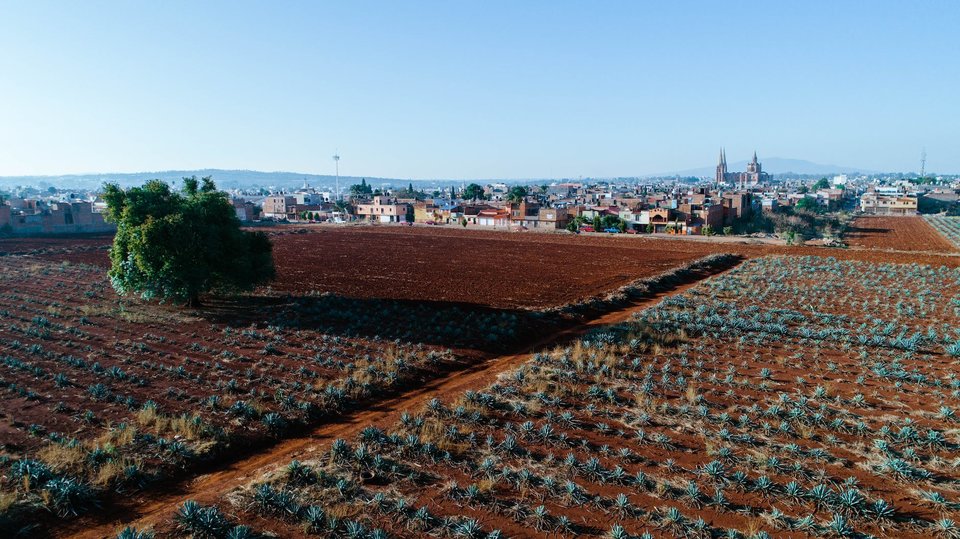
It all starts with agave.
Agave
A note on maturity, bats, and sustainability
Just before flowering, the concentration of sugars in the plant is at its highest, which is good news from a production point of view. More sugar means more alcohol. However, after flowering, the agave ends its lifecycle, so growers will tend to chop emerging flowering stalks off so that the plant redirects its energy into growing larger, and storing more sugar.

A flowering quiote growing from an agave plant.
This is where bats also come in. For lesser long-nosed bats, agave flowers are a key food source, and for agave plants, lesser long-nosed bats are the primary pollinators. These bat populations are under threat, with reduced food sources being one of the reasons for this. Growers are being encouraged to let some of their agave crop flower to support bat populations. A recent initiative aims to make this visible to consumers, and Tequila where 5% of the agave crop has been allowed to flower can display a label on the bottle certifying that it’s Bat Friendly™.
Bats pollinating agave flowers also has benefits for the genetic diversity of the plant. Blue agave has been clonally propagated by replanting shoots that appear at the bottom of the plant, which means that farmed agave used for Tequila has very low genetic diversity as it’s mostly copies of the same plant. This is especially bad when it comes to pathogens affecting blue agave, as genetic diversity means they’re better able to withstand pathogens.
For Tequila producers, the long time it takes to grow blue agave, coupled with the increasing demand for Tequila, puts pressure on the supply chain, and it can be tempting to harvest plants before they reach peak maturity. However, it’s a balancing act; with many producers and drinkers choosing Tequila that states longer growing times, which tends to imply more considerate growing practices; and others choosing to use younger plants, preferring the character of the Tequila they make.
Agave harvesting
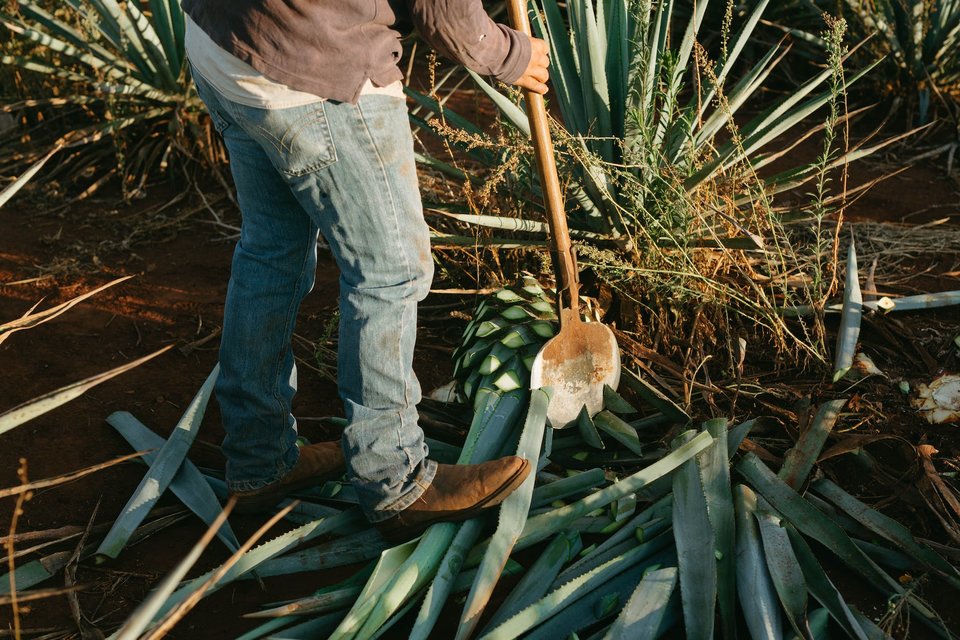
A sharp coa is used to trim the pencas to reveal the piña, which will be used to make Tequila.
A jimador uses a tool called a coa de jima, which looks like a sharp, round shovel. With a coa, the jimadores trim some of the pencas off, before lifting the agave plant out of the ground. This isn’t without its risks; agave fields make a pretty cosy home for all sorts of snakes; the sap from agave contains irritating crystals called ‘raphides’ which can lead to dermatitis; and you could lose a few toes if you don’t know what you’re doing with a razor sharp coa. Best left to the professionals we reckon.
The coa is then used to cut back the remaining leaves, revealing the large, sugar-filled inner heart of the agave called the piña, which looks a bit like a giant green and white pineapple. This is what will be used to make Tequila.
How much of the penca is trimmed off varies, some producers choose to use piña with a fair amount of the green penca left on, and others prefer to trim it down so the piña is nearly all white.
Before it gets cooked, piñas are chopped into pieces and the cogollo is removed. The cogollo is a bud-like section that forms at the top of the piña. It tends to be removed as leaving it in can result in unwanted flavours in the final Tequila – although sometimes it’s left in.
Cooking agave
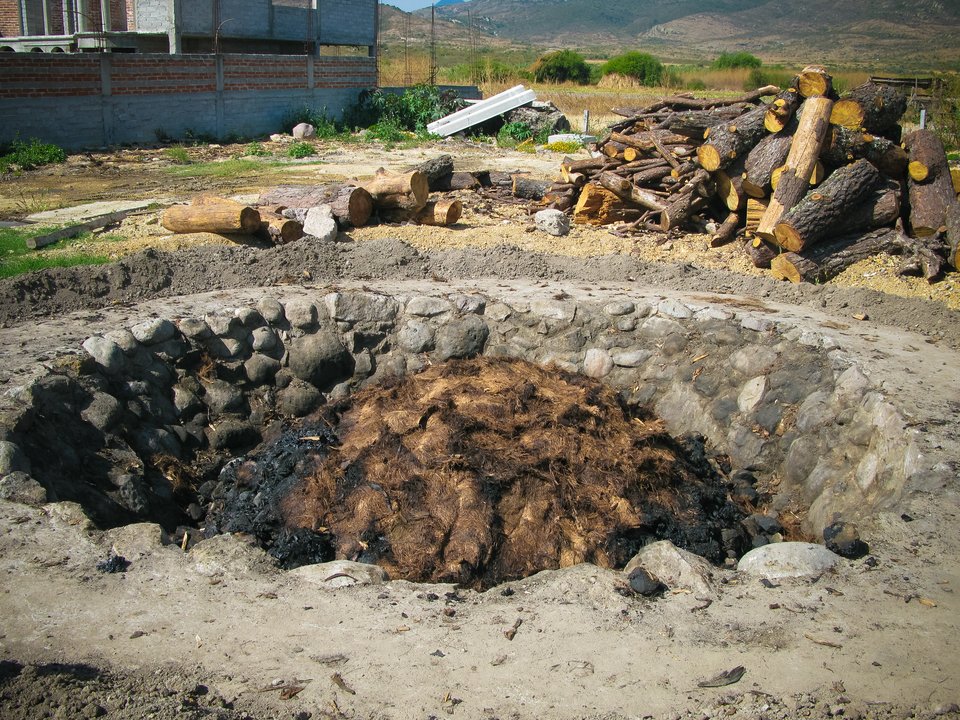
An old school sunken fire pit for cooking agave.
There are several methods for cooking piñas. One of the oldest methods is a sunken fire pit called a horno de pozo, but this is now rarely used for Tequila as methods more suited to large-scale production have become popular.
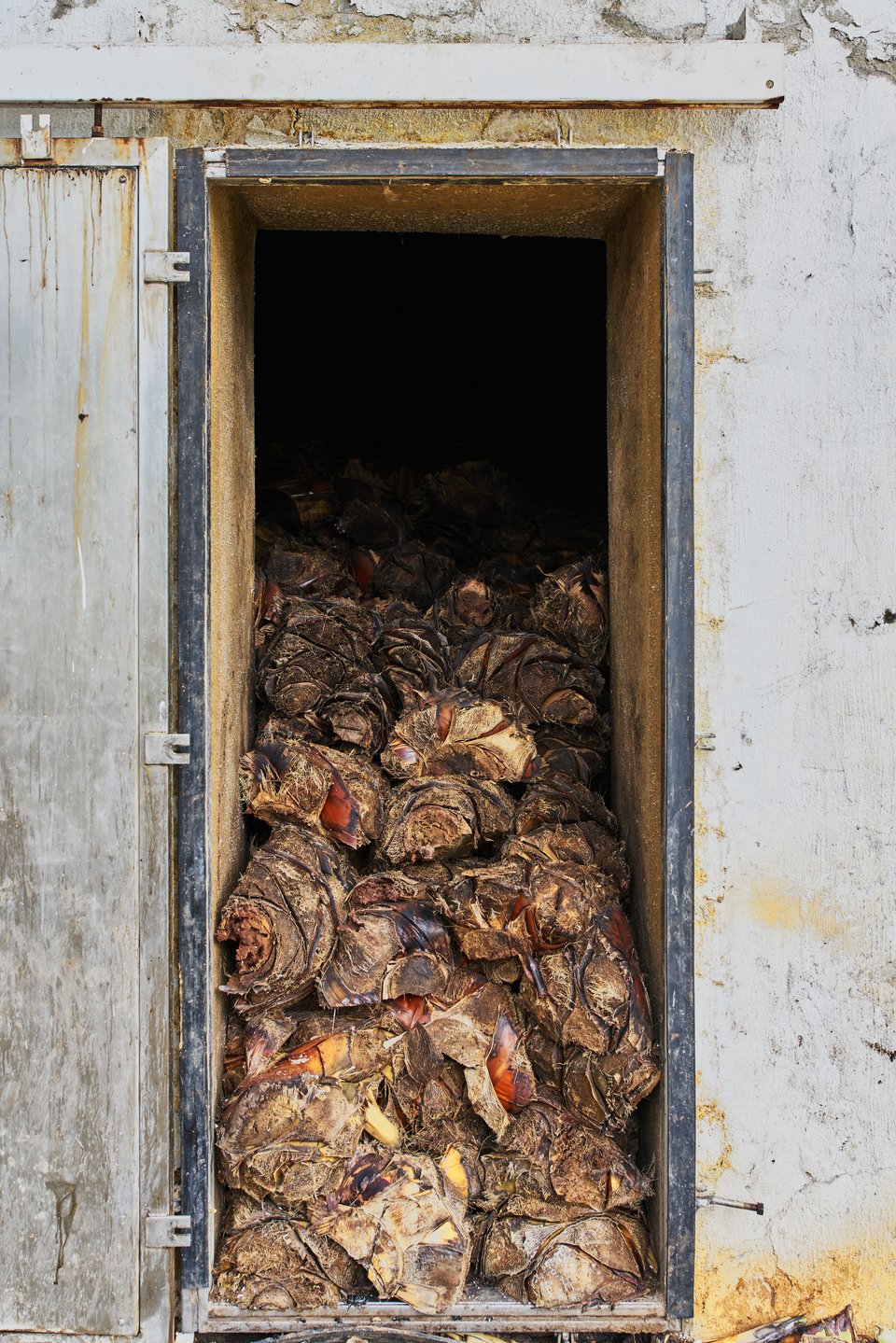
Stone or brick oven (horno) full of cooked agave.
Steam cooking piñas in large ovens is common now, and two main methods are used. Hornos de mampostería, or hornos, are ovens made of stone or brick. Piñas are put into these sealed ovens and steam is injected to cook the agave before it is left to cool down. This entire process can take anywhere from two to three days to complete.
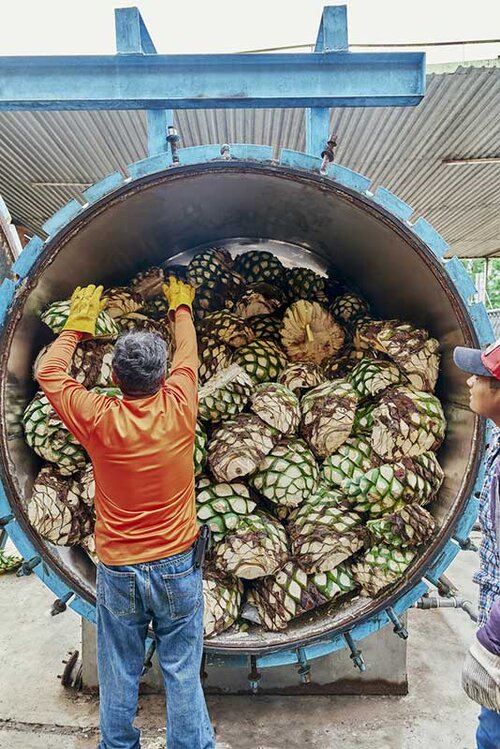
Autoclaves being filled with agave, ready to be cooked.
Another method to cook agave for Tequila is using autoclaves, which are large, pressurised, steam-injected ovens. Autoclaves can reduce the entire time taken to cook and cool the agave dramatically, although the pressure can be reduced to cook the piñas more slowly. The capacity and reduced processing time of autoclaves makes them particularly suited to large-scale Tequila production.
What are diffusers?
People in favour of diffusers usually point to the time-saving and environmental benefits, citing them to be more energy efficient than ovens, with very little fermentable sugar wasted with around a 95% extraction efficiency.
Many producers and Tequila drinkers oppose the use of diffusers, especially when used for uncooked agave, claiming they make Tequila too far removed from the complex characteristics that people love.
Extracting the juice

A tahona filled with cooked agave.
Another traditional method is using a tahona. This is a sunken pit where a large stone wheel is pulled around the pit to crush the cooked piñas. The stone can weigh around two tonnes and was traditionally pulled by a donkey, although nowadays they’ve been replaced by tractors. A small number of Tequila producers still use this method, which has now been largely replaced by mechanised mills that crush the piñas and extract the juice from the fibres. The can range in size and complexity, from fairly small to industrial sized machines. And then there are diffusers, which are mentioned above.

Large-scale mechanised mills are more common nowadays for crushing agave.
Fermentation

Open wooden vessels are a popular choice for fermenting agave.
Fermentation can happen in many different vessels, usually open or closed wooden, cement, or stainless steel tanks. Yeast and nutrients can be added to the mixture, or it can be left to ferment spontaneously thanks to the natural yeasts and bacteria in the atmosphere of the distillery. Spontaneous fermentation is often a long process, and this slower style of fermentation gives huge amounts of flavour and aroma to Tequila. Faster fermentations won’t have as much time to develop some of the more complex flavours. A bit like sourdough bread vs your standard loaf.
Sometimes, fibres left over from crushing the piñas are added to the fermentation mixture, which can help with creating more flavourful Tequilas, and aid the fermentation process in general by creating a sort of lid on open air tanks.
Distilling Tequila
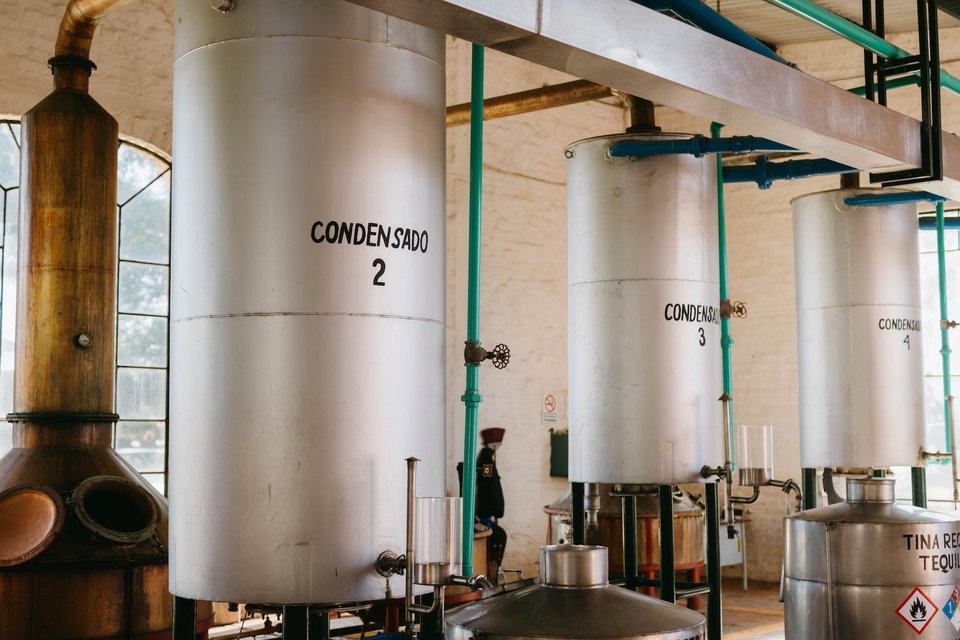
The stills used to distil Tequila can vary in size.
What happens after distilling Tequila?
Additives, abocado, and Tequila
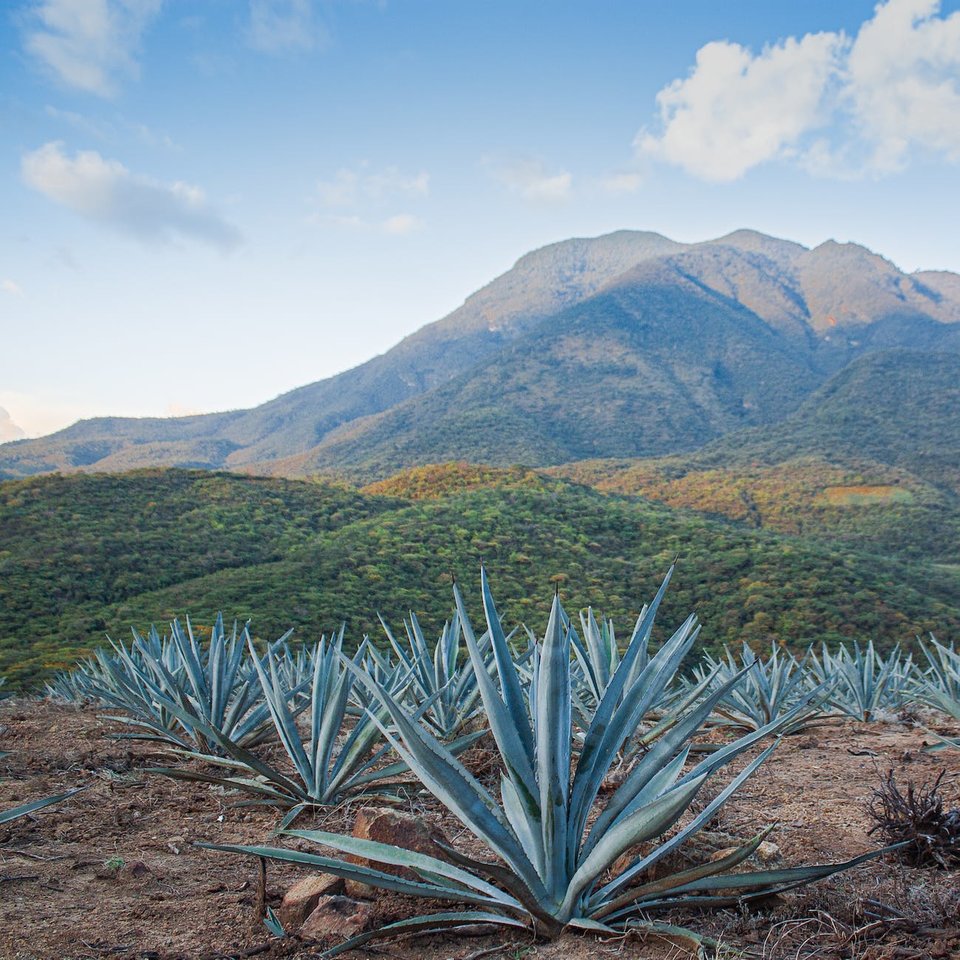
Delicious Tequila in waiting.
More Tequila guides
Discover more whisky guides
Find out how whisky is made, about the different types of whisky available, and more...
Explore more
Sign up to our newsletter
Special offers, recommendations and expert advice to your inbox! Unsubscribe at any time.
I agree to the Privacy Policy









